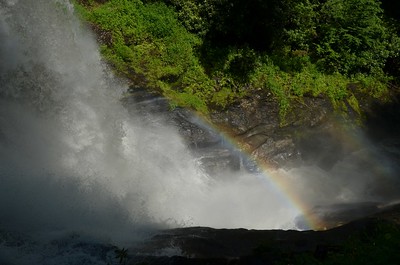Chasing Rainbows (and a How To)
I was putting up Christmas lights on the house and it kept sprinkling on me. Then, the next thing I knew, the Sun broke through even though the sky was almost black. So I raced down to the lake hoping to catch a rainbow. It never showed up but I thought you’d like to see my what my normal sunrise spot looks like at sunset.
(If you want to know how to chase rainbows, keep scrolling down.)

Nikon D7000 -- Nikon 18-300mm 6.3 ED VR
18mm
F8@1/160th
(BOB_4404)
©Don Brown 2019
How to Chase Rainbows
Whenever I go off chasing rainbows (literally) I am reminded of Galen Rowell. Except for the guy that taught me photography (Hi Bill), no one else comes close as an influence on how I think about photography. If you haven't heard of Galen Rowell, I'd encourage you to read this article in Outdoor Photographer. And as far as I'm concerned, his books were masterpieces on the art of photography and how we see. As you read the article, you will most likely recognize his iconic image of a rainbow over Potala Palace.
I believe his instructions for chasing rainbows were in one of his books. Wherever I learned them, I never forgot them. (The only photography seminar I ever paid for was one of his in the Great Smoky Mountains.) So let's get down to it.
As any kid with a garden hose and sprayer knows, it only takes sunlight and water drops to make a rainbow. It doesn't have to be rain, but there has to be some kind of water droplets. (For instance, at many large waterfalls, you can find a rainbow in the spray.) So where do you look to find a rainbow? Your shadow points the way.

You must first find the anti-solar point. In other words, locate the Sun (notice I didn't say "look at the Sun"), and then find the point directly opposite of the Sun -- the anti-solar point. A rainbow forms in an arc around that point. (I *think* it's a 42º arc around the anti-solar point but I promised myself I wouldn't get bogged down in the minutiae.)
Put your thinking cap on now. If you go out in a rainstorm at noon, where is the anti-solar point? That's right, at your feet. Now look around in arc around your feet and you aren't going to find a rainbow (nor a pot of gold). Likewise, you can go out in the rain at midnight...oh, never mind. You get the point. This is the reason you are most likely to see a rainbow in the sky around sunrise or sunset. And it should now make sense as to why I was standing in my sunrise spot at sunset, chasing rainbows.
Its just that simple. I'll let you work out some of the other details on your own. Those that are interested will. That that aren't won't. (But you'll never learn about a Moonbow.)
Don Brown
December 8, 2019


Comments